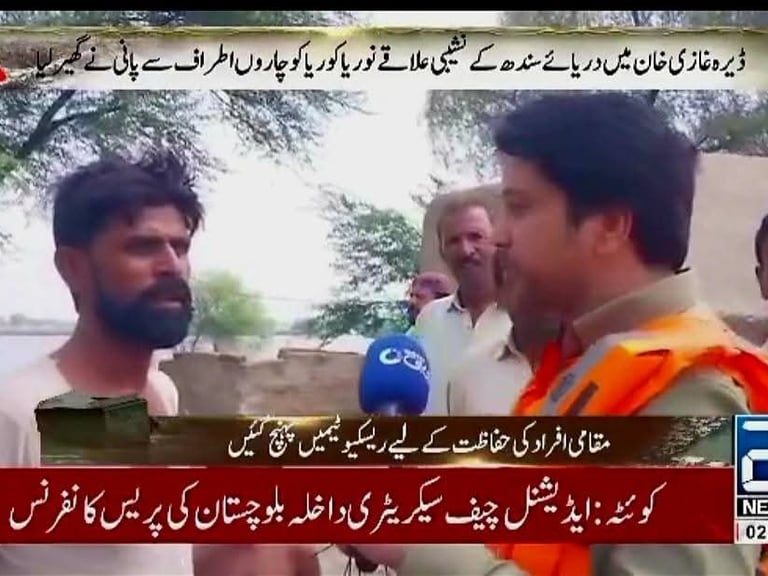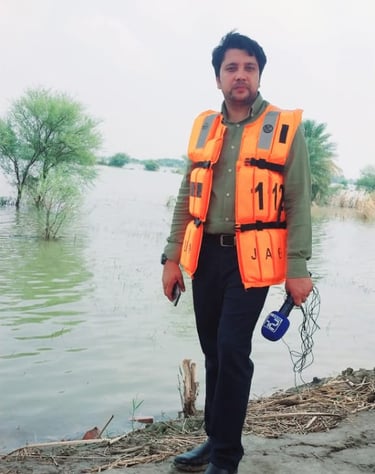Punjab floods and its social implications
While the flooding is widespread, certain districts have borne the brunt more than others.
Iqbal Sadiq, Bureau Chief, 24 News
11/15/20254 min read


Iqbal Sadiq's meeting with Interior Minister, Mohsin Naqvi


In 2025, monsoon rains combined with unusually high water release from upstream sources triggered one of the most devastating flood events in Punjab’s recent history. Rivers such as the Chenab, Ravi, and Sutlej breached danger levels, overwhelming embankments and submerging vast parts of the province.
According to the Punjab Provincial Disaster Management Authority (PDMA), 27 districts were affected, with over 4,700 villages inundated. The scale of human impact is immense: more than 4.7 million people have been affected, with 2.637 million displaced, and 2.117 million livestock relocated to safety. Tragically, at least 131 people have died, and hundreds more are injured.
Iqbal Sadiq reporting on field during Punjab Floods 2025
Iqbal Sadiq with Deputy Commissioner Lahore during floods




The flood also brought widespread infrastructure and economic damage. Nearly 161,000 homes have been damaged (115,700 partially, 46,000 fully destroyed), and about 395 health facilities (out of 742 assessed) suffered structural damage, with 315 centers severely affected. Agriculture, the backbone of Punjab’s economy, was particularly hard hit: between 1.3 million to 1.5 million acres of farmland were submerged, including large damages to rice, cotton, and sugarcane crops.
While the flooding is widespread, certain districts have borne the brunt more than others. Among the worst-hit are Muzaffargarh, Multan, Dera Ghazi Khan, Rajanpur, Rahim Yar Khan, Lodhran, Bahawalpur, Layyah, Faisalabad, Sialkot, Narowal, Okara, Hafizabad, Sargodha, and Kasur. The common thread is that many of these lie along or close to the major rivers – Chenab, Ravi, and Sutlej – making them particularly vulnerable to high riverine flows and bank breaches.
Impact and Risk Analysis:
1. Humanitarian Impact
Displacement: Millions of people displaced; thousands living in relief camps.
Mortality and Injury: Over 130 lives lost, and many injured.
Health Risks: Overcrowding in temporary camps, poor sanitation, and stagnant water are raising fears of disease outbreaks. The cases of cholera, dengue, malaria have been reported while meeting people on field.
2. Economic and Infrastructure Damage
Agriculture: Massive loss of crops (rice, sugarcane, cotton), threatening farmers’ livelihoods and provincial food security.
Housing: More than 60 thousand homes damaged or destroyed. The governement has set up a data system to register houses and to add distribution mechanism accordingly.
Health Infrastructure: Hundreds of healthcare facilities damaged, impairing medical services when they are most needed.
Transportation: Roads, bridges, and key transport infrastructure have suffered major damage, hampering relief and supply operations.
3. Environmental and Agricultural Risks
Soil erosion, loss of topsoil, and sedimentation may degrade long-term agricultural productivity.
Livestock losses and displacement further threaten food security and farmers’ incomes.
4. Institutional and Governance Risks
The scale of displacement and damage is testing the capacity of the PDMA, government agencies, and humanitarian actors.
There is risk of misallocation of relief, delayed compensation, and weak coordination.
Government Response to the floods:
The Punjab government, through the Punjab Provincial Disaster Management Authority (PDMA) and other agencies, has initiated a multi-pronged response to manage the crisis. Some key actions include:
Relief Camps & Evacuation: The government has established 271 relief camps and 300 medical camps in flood-affected areas. Mass evacuations have moved over 2.6 million people to safer locations, along with over 2.1 million livestock.
Rescue and Medical Support: Rescue operations involve local authorities, the army, and disaster response teams. The establishment of medical camps ensures basic healthcare services, while veterinary camps support displaced livestock.
Damage Assessment: Starting September 24, the government began flood damage surveys, aiming to transparently assess losses.
Compensation: Compensation systems are being designed to facilitate relief payments to affected people. According to PDMA, this will be done through a transparent and simplified process.
Technical Support: The space agency SUPARCO is providing satellite imagery to map submerged villages, monitor infrastructure damage, and help prioritize evacuation routes.
Coordination and Alerts: Provincial authorities are coordinating with national agencies, updating river water levels, and issuing flood warnings.
Infrastructure Recovery: Efforts are underway to repair damaged roads and bridges, though this will require sustained funding and coordination.
Public Health: Given the risk of waterborne diseases, hygiene and health interventions are being scaled up, including mobile clinics and emergency toilets in camps.
Nearly 161,000 homes have been damaged (115,700 partially, 46,000 fully destroyed), and about 395 health facilities (out of 742 assessed) suffered structural damage, with 315 centers severely affected. Agriculture, the backbone of Punjab’s economy, was particularly hard hit: between 1.3 million to 1.5 million acres of farmland were submerged, including large damages to rice, cotton, and sugarcane crops. Among the worst-hit are Muzaffargarh, Multan, Dera Ghazi Khan, Rajanpur, Rahim Yar Khan, Lodhran, Bahawalpur, Layyah, Faisalabad, Sialkot, Narowal, Okara, Hafizabad, Sargodha, and Kasur. The common thread is that many of these lie along or close to the major rivers – Chenab, Ravi, and Sutlej – making them particularly vulnerable to high riverine flows and bank breaches. To strengthen the flood response and build resilience against future disasters, the Punjab government should consider the policy measures and actions to combat it and solve people's issues.


Iqbal Sadiq serves as Bureau Chief at 24 News and Rohi TV, having 8 years of experience in electronic media. He belongs from Kasur, Punjab. He has extensive experience in field reporting, editorial coordination and investigative coverage in South Punjab. He holds a Masters degree in Communication Studies from the University of Lahore.
